Stories and Photos from Old Carcar
Preserving the architectural heritage in the Philippines is a struggle in the face of modernity. I have visited my share of towns with a critical mass of old Hispanic houses but none is more impressive than Vigan in Ilocos Sur. It was not declared a UNESCO World Heritage town for nothing. If I would be pressed to shortlist some other towns, I would certainly include Chavayan (Sabtang Island, Batanes), Silay (Negros Occidental), Bantayan (Bantayan Island, Cebu) and Carcar (Cebu).
It is in this context that I was excited when Gibbster and John, both lumad Carcaranon (true blue natives of Carcar) invited me, my wife Dia, Tet and Jenny to witness and document Carcar’s fiesta. We could not come on November 25, the kahulugan or actual feast day when the Kabkaban street mardigras would be held. Instead, we chose to visit on the eve or bisperas, November 24, which is a bigger deal for me as the town would be holding the traditional candlelight procession. This year, the Carcar Heritage Conservation Society is sponsoring a Festival of Lights, a choreographed street dancing around the 4 processional tableaux. Think of flaming handtorches and lamps on salakots (native leaf hats). As Gibbster is a member of the Carcar Heritage Conservation Society, the youngest in fact, he definitely can usher us into old houses that otherwise will remain off limits to strangers. He did that and more.
Sta Catalina
The city of Carcar honors St. Catherine of Alexandria (ca 287-305 AD), or Sta. Catalina in the vernacular, she who was legendarily tortured and beheaded for her faith. As oral accounts go, the image first used in the fiesta procession (before the war?) was the ivory image of the Valencias (below); but when the Noels gained political and financial prominence, their image of the Sta Catalina was bestowed the honor and the Valencia icon was hidden for safekeeping. By a twist of fate, a Valencia heir later on married a Noel and in the late 1990s, the tradition of using the Valencia icon in the town procession was restored.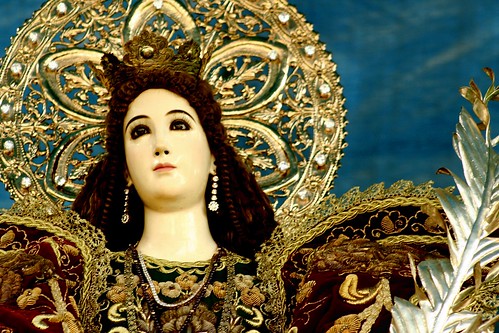
phototip: Sometimes background can be distracting. I took the opportunity of photographing the antique ivory image of the Valencia family while it was sheltered under a blue tarp inside the Osmeña-Valencia family compound, while waiting to be paraded in the street.
f/5/6, 0.008s, 170mm, ISO 400, +1/3EV, uncropped
at the Balay na Tisa, the Ancestral House of the Sarmientos (Osmeña-Valencia), Carcar City, Cebu
This is not to say that the Noel image is no less revered. Unlike the youthful virgin-like beauty of the Valencia image, the life-sized Noel Sta Catalina has a more mature and knowledgeable countenance. It still is honored and is reserved a prominent altar at the left transept inside the Church of Carcar.
phototip: Add a human element when photographing religious iconography.
f/5/6, 0.04s, 41mm, ISO 1600, +2/3EV, slightly cropped
student volunteers before the antique Sta Catalina image owned by the Noel family honored inside the Church of St. Catherine of Alexandria, Carcar City, Cebu, the Philippines
Expression of faith
Fiestas are a time of reuniting with friends and family, of bringing out the best family porcelain and home-cooked recipes, but most of all, of paying homage to the patron saint. The essence of fiesta is faith so I always would try to capture prayer in its communal and personal form, whether of people jostling inside the church or of visitors offering candles, oftentimes accompanied by the now-famous sinulog dance. I chose to represent the solemn part of the fiesta celebration with a closeup shot of a hand offering candles outside the church. Petitions here are often said in silence.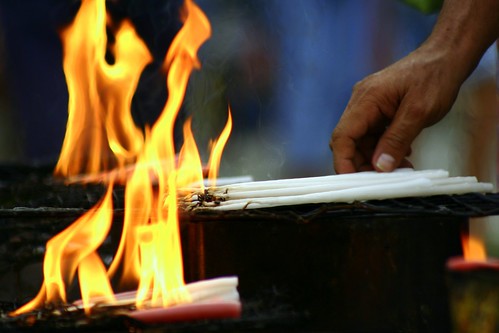
phototip: Simplify, simplify, simplify.
f/5.6, 0.002s, 255mm, ISO 200, uncropped
at the communal candle offertory outside the Church of St. Catherine of Alexandria, Carcar City, Cebu, the Philippines
Houses of Heritage
According to the Carcar Heritage Society, there are close to 50 houses that were built in the mid-1800s to the early 1900s. With such a unique setting therefore, Carcar was proclaimed a heritage town in 2005 by the province. Numerous are the grand buildings in Carcar, from the filigreed dispensary to St. Catherine College to the Sato Mansion, where Leon Kilat (General Pantaleon Villegas), the famous revolutionary, was killed by Spanish loyalists in 1898. On a personal note, my father’s older sister married an Avila in Valladolid, Carcar who inherited an opulent ancestral house complete with a fountain, a mini-piazza with imported statues and Italian glass windows although the manor has sadly fallen in disrepair, as have most houses in Carcar. With so little time, we have to limit our photographic tour in Carcar to just about two houses, the Balay na Tisa of the Sarmientos/Osmeña-Valencia and the Dakung Balay (the Big House) of the Noels.
Balay na Tisa
The house lays claim as the oldest in Carcar and the only one with the extant original tisa or clay tiled roof. It has a marker which dates the construction of the house to February 2, 1859.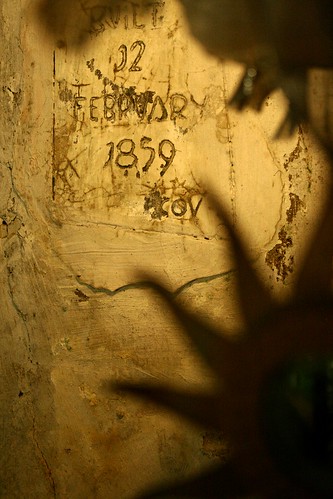
phototip: Frame plain objects. I used the Christmas decors hanging from the ceiling to frame the flat marker to add visual interest.
f/5.6, 10.01s, 44mm, ISO 1600, -1/3EV, uncropped
construction marker of the Balay na Tisa, the Sarmiento ancestral house, Sta Catalina St, Carcar City, the Philippines
Based on oral accounts and from what I gathered in the internet, the house was built by Don Roman Sarmiento and Doña Ana Canarias. In Philippine society, the appellations Don and Dona refer not just to the literal Mr. and Mrs. but are reserved titles for the old Spanish or mestizo Spanish gentility. Definitely, affluence was to the Sarmientos born. They not only built a house made of bato or stone (specifically coral), they used clay tiles for the roof or tisa.
The couple only had 2 children, both girls. As the elder daughter who married a Urgello died young, the house was bequethed to the younger daughter who married an Osmeña. The Osmeña’s only child, also a daughter, married a Valencia. No wonder then that the house is referred to by many names, the Sarmiento or Valencia or more popularly, the Osmeña-Valencia house.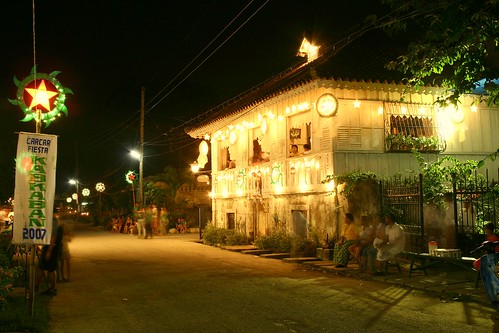
phototip: Fiesta night scenes are a treat, far more colorful and vibrant. The house is closed in ordinary days and is occupied only by a caretaker. The owners visit the house only on occasions, most specially, the Semana Santa (Holy Week) or the fiesta (Nov 24-25).
f/8.0, 10.0s, 25mm, ISO 100, slightly cropped
the Balay na Tisa, the Sarmiento or the Osmeña-Valencia ancestral house, Sta Catalina St, Carcar City, the Philippines
There is a side spin to the house’s history. In the 1980s, an heir who lived in house, ran into financial trouble, and allegedly sold almost all of the antique appointments. After the house was recovered by other family members, they tried to slowly, painstakingly and silently, buy back their lost heirlooms. No amount of money and influence could recover all the losses but over time, the heirs succeeded in populating the house with vintage, reproduction and antique furnishings, with some recovered originals. I know of an antique dealer in Minglanilla who helped search for the sold items and narrated to me this tale even before I visited the house. But without doubt, the house is now a veritable museum of beautiful porcelain, crystals, silver and woodwork. Not only are the interiors impeccably restored, the decorations are tasteful and unmistakably classy. We left with our mouths all agape.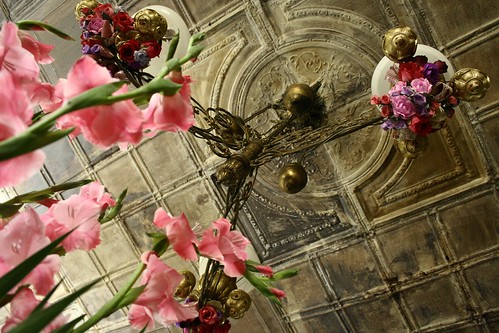
phototip: Look straight up. I had to kneel to get this shot but the different perspective is rewarding.
f/5.6, 0.013s, 18mm, ISO 1600, -2/3EV
detail of the ceiling in hammered tin that is probably original to the the Balay na Tisa, the Sarmiento or the Osmeña-Valencia ancestral house, Sta Catalina St, Carcar City, the Philippines
Dakung Balay
If we were floored by the luxury of the Osmeña-Valencia house, we were ushered back in time by the Noel ancestral home. Now the residence of Jerry Martin Alfafara, the PRO of the Carcar Heritage Society and contributing writer to magazines like the Metro Society, the house is huge. Downstairs, there is ample space for parking and commercial warehousing, as the house probably was sometime in the past. Like the Balay na Tisa, the house has a grand wooden staircase which connects the stone-walled ground floor and the wooden second storey structure. The floors upstairs still have the original interspersed planks of what look to me as fine-grained yellow tugas (molave in Tagalog) and dark bayong (tindalo in Tagalog), all varieties of hardwood that are now rare.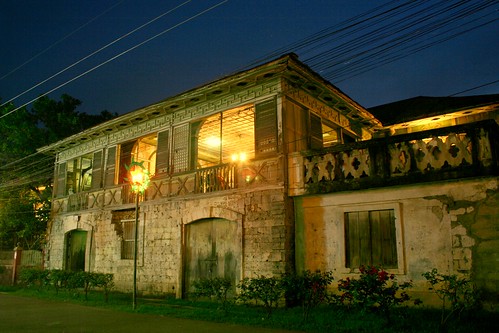
phototip: Recreate the atmosphere of the scene. The interior of the house is as somber, if not “haunted” in feel, so I shot a picture in the dark, timed when no one was in view, to depict a sense of desolation.
f/18, 20.0s, 30mm, ISO 100, uncropped
the Noel Ancestral House, Carcar City, Cebu, the Philippines
The furnitures clearly are as old as the house. Most notably, I saw a dining table which features the kalabasa (squash) foot design, indicating that the piece is probably made by Ah Tay, the renowned late 19th century furniture maker from Manila. The four posters of the huge bed also are impressive for they are hand-carved and not mechanically turned, indicating how expensive the bed must have been even during its time. The current dining room is sized like a ballroom and so is the open aired veranda. There are also living quarters behind the traditional old kitchen at the back which appear to be occupied by a family helping out with the upkeep of the house.
While the house foundations and walls are generally intact and solid, a lot of the interiors were consigned to the ravages of time. Take for instance the paint and wallpaper in the living room which were allowed to flake. Decoration was sparse and lighting was dim, adding an eerie atmosphere of mystery in the house. My lady companions certainly were too unnerved to go to the toilet alone, which by the way, was thoroughly modern. For additional old air ambiance, the homeowner’s computer was packed and stored away from view. I saw no radios, phone or television. How‘s that for effect?!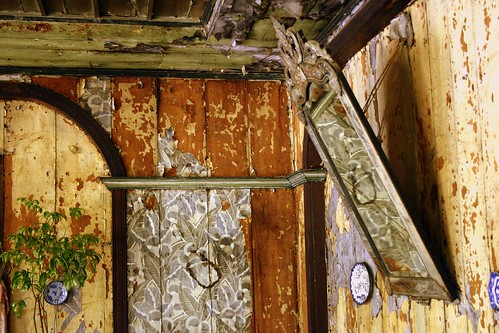
phototip: Experiment with angles when shooting subjects with mirrors. From where I took the picture, the antique Venetian mirror was able to reflect and highlight the patterns of the flaking wallpaper.
f/4.5, 0.013s, 31mm, ISO 1600, -1/3EV
details of the flaking paint and wallpaper, the Noel Ancestral House, Carcar City, Cebu, the Philippines
Part 2: Documenting Carcar’s Festival of Lights






2 comments:
a great article for a great city. t'was a great day to for all of us.
gibb
Maravillosa historia :))
Una casa realmente hermosa. Gracias por traerla hasta aquí
louna
Post a Comment